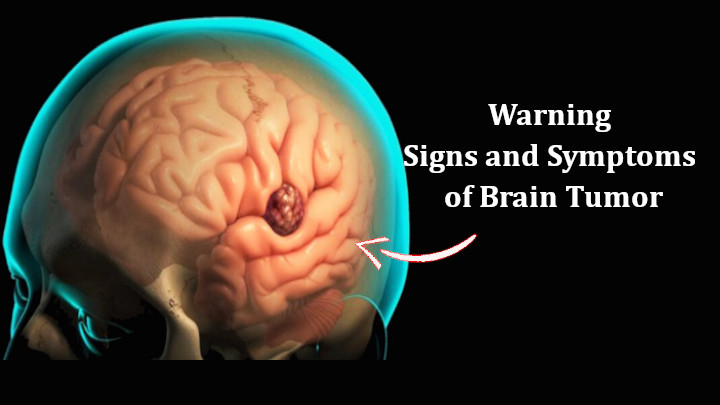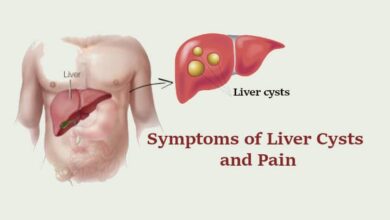Early Signs and Symptoms of Brain Tumor in Women and Men

A brain tumor can be defined as a life-changing occurrence, but it’s not a death sentence. Undoubtedly the human brain has the most complicated network to live with.
It consists of billions of nerves that conduct total communication. This silent worker starts to function from the very beginning we are born and never takes a moment off.
So the brain matters a lot as far as life’s existence and our daily activities are concerned. Healthy brain activity may be hampered by the development of the tumor inside the brain.
We know that it is a worrying moment for individuals with a brain tumor as the word tumor is scary enough.
But with the progress of modern medical technology and surgical modalities, the brain tumor is no longer terrifying as it was in the past years.
It is curable if diagnosed at an early stage. This article will discuss signs and symptoms of brain tumor in women and man. Possible treatment to reduce the fatality rate.
What is Brain Tumor?
Tumors are abnormal growth of tissues. It can be benign or malignant. Tumour may develop at any part of our body or inside the brain also. Therefore the brain tumor is the development or collection of abnormal cell growth inside the brain.
It is also known as an intracranial tumor in which cells grow and mutate rapidly. However, the human brain is enclosed with a bony structure, which is known as the skull.
It is a very restricted space, and any tumor may increase the pressure inside the skull. This can be very dangerous and life-threatening and may cause brain damage.
Brain Tumor Facts
- A brain tumor can develop at any age.
- Primary brain cancer is rare. All types of brain tumor are supposed to grow as a secondary tumor, which means they spread to
- The real cause of brain tumors is yet unknown.
- Survival rates vary from person to person.
- Despite being a less common type of cancer, a brain tumor is the most life-threatening due to its location.
- There is no chance of further spreading in a benign brain tumor, and it can be removed through surgery.
- Malignant brain tumors spread rapidly and affect brain functions.
Signs and Symptoms of Brain Tumor in Women and Men

Do i have a brain tumor? You may not have a brain tumour, but certain types of symptoms should be investigated. You’d have some unpleasant early signs of brain tumor.
A brain tumor can start in the brain or spread from elsewhere from the body to the brain. Signs and symptoms of brain tumor in women and men may vary in each case. The factors on which symptoms depends are—
- Size of the tumor.
- Type of the tumor.
- Location of the tumor.
Moreover, it is worth mentioning that the signs and symptoms of a brain tumors can be general or specific. The general symptoms are created by pressure on the brain caused by a tumor.
The specific cause comes out when a particular part of the brain is affected, and the tumor cause that specific part not to function well.
What are the early signs of brain tumor or cancer? Let us discuss the symptoms category wise-
General Signs and Symptoms of Brain Tumor
Brain tumors in men and women may appear in different shapes and sizes, which applies to their symptoms. The signs and symptoms of brain tumor in women and men are as follows-
A. Frequent Headache

Symptoms of a brain tumor headache: Severe headache is a common indication of tumor growth in the brain. When a tumor develops inside the brain, it causes heavy pressure on the brain’s nerves and blood vessels.
This situation can create the following changes in your old pattern of headache. Such as-
- You have no history of migraines, but you have constant headaches.
- The pain is severe in the morning.
- Sometimes there is vomiting or other more problems with a headache.
- The pain becomes worse if you move or sneeze, or exercise.
B. Seizures

Seizures is most common signs of brain tumor. This word may sound a little unfamiliar, but it merely means the brain’s electrical activity. A brain tumor occupied the space inside the brain and put pressure on the nerve cells.
This can react with electrical signals and cause the neurons to get excited and create uncontrolled electrical disturbance in the brain. This can result in changes in behavior and also the consciousness level.
A seizure can extend from mild to severe, depending on the type or location of the tumor.
A seizure may occur due to other neurological problems. So seizure does not always indicate tumor growth. Seizure symptoms include—
- Confusion.
- Jerking movement of hands and legs, which is uncontrollable.
- Lack of consciousness.
- A seizure may be the first symptom of a brain tumor.
- Changes in sensitivity, vision, or smelling power.
- Memory shortage.
- Drowsiness.
The specific symptoms mainly depend on the location of the tumor. These signs and symptoms of brain tumor in young adults include:
- Pain or headache near tumor growth.
- A problem in muscle movement and loss of body balance.
- Uncontrolled facial expression.
- The tendency to miss footsteps.
- To fumble while searching for things.
- The affected person may lose his vision entirely or partially if the tumor develops in the occipital or temporal lobe of the cerebrum
- Changes in speech, facing problems in communication with other people, and emotional level changes can occur if the tumor grows in the cerebrum’s frontal and temporal lobe.
Read Also: Foods that Boost Brain Power and Memory
Causes and Risks of Brain Tumor
The exact cause of brain tumors is unknown. But the moment any person comes to know that he/she has a brain tumor, it’s natural to be worried about what may have cashed the tumor.
Doctors also have no specific answers about why one person has developed such a tumor, but another doesn’t.
It is assumed that certain risk factors enhance the chances of brain tumor growth. Those risk factors include: (Reasons for brain tumor)
a.) Exposure to Ionizing Radiation
Individuals exposed to high radiation therapy from a large machine pointing at the head or receiving X-rays from other sources are more likely to develop brain tumors than other people.
This type of radiation damage the brain cell, and this leads to the formation of a tumor. Also, ionizing radian may cause a brain tumor known as meningioma.
b.) Previous Family History
Some genetic factors or conditions raise the individual risk of growing tumors inside the brain.
It is assumed that only 5% of brain tumor cases are linked with hereditary factors. The genetic conditions are-
- LI-Fraumeni syndrome.
- Neurofibromatosis.
- Nevoid basal carcinoma.
- Tuberculosis.
- Tucot syndrome.
- Von Hippel-Lindau disease.
Medical scientists have found a similar cluster of tumor cells in the same families without these links.
- Exposure to certain viral infections or allergies.
- An electromagnetic field’s role, such as overuse of mobile phones, maybe cause brain tumors in adults.
How to Diagnose a Brain Tumor
Brain tumor does not come with specific symptoms, and therefore, it is very tough to assume whether it is a tumor or anything else in case of abnormal cell growth in the brain.
Early warning signs brain tumor like nausea, headache, blurred vision, balance problems are a combination of signs that may indicate other health issues.
Sometimes, the absence or lack of corresponding signs of other causes can indicate the necessity to investigate brain tumor growth possibilities.
The tumor, located in other parts of the body, may show the same characters and obstacles. But obviously, such symptoms cause specific issues that are related to the affected organ.
So a thorough and accurate procedure is the first task to be followed to detect a brain tumor.
So if you are undergoing such phrase and symptoms like a tumor growth in the brain, your medical advisor will suggest many tests diagnose brain tumors and their type ad location.
1. Neurological Checking
Neurology includes the entire nervous system that connects the brain and spinal cord. An in-depth examination is the first step as our brain consists of nerve cells connecting tissues.
- Neurological check-ups involve a series of tests, testing the controlling power of the brain.
- It also helps to reveal which part of the brain is affected.
- Among other things, neurological tests check an individual’s vision power, smell, and body balance. It also tests whether the brain is coordinating with the different parts of the brain or not.
- If there are problems or difficulties in any area, it is counted as an indication that the brain’s particular part could be affected by tumor growth.
2. Analysis by Imaging
In medical science, imaging plays a vital role in diagnosing any critical health issues like a brain tumor. With the advancement in the medical field, there come high-resolution techniques that are non-invasive too.
To detect a tumor in the brain, the following imaging tests can be recommended by your doctor.
a). MRI
Magnetic resonance image is often used to detect brain diseases. In this process, a powerful magnetic field radio frequency pulses and a computer are used to get a clear picture of soft tissue bone structures, foreign materials inside the organ, and all other kinds of stuff.
Through MRI, any brain abnormalities can be detected in detail. The high sensitive magnetic field detects tumors and evaluates the adjacent areas to define its extent.
b). Spine MRI
Unlike MRI of the head spine, MRI also sued to show the anatomy of the vertebrae and spinal cord and the internal spaces between the vertebrae through which all the nerves pass. This test is helpful to detect tumors that develop in or spread to the spine.
C). FMRI of Brain
Functional magnetic resonance imaging or FMRI calculates the small changes in blood flow in brain activity.
When our brain remains more active, it consumes more oxygen, and blood flow is also increased to the active area. Through the growth and development of a tumor and assess the risk of surgery.
d). CT Scans of the Head Area
Usually, computerized tomography or CT scan hep to estimate any injuries related to the head or brain, severe headache, or brain tumor.
This process involves special X-ray equipment with a highly sophisticated computer to create multiple images of the tumor.
e). Cerebral Angiography
Angiogram is a series of X-ray images taken after injecting a specific dye into your body’s blood vessel. Venogram or arteriogram. After infecting the blood vessels of your brain.
Now with the X-ray Image, it becomes easy to identify the tumor and the joining blood vessels.
f). Diffusion Tensor Imaging (DTI)
With the help of the DTI test, the doctors try to find the brain’s neural pathways, which is useful to remove the tumor.
g). Skull X-ray
Certain types of tumors can leave calcium deposits. A skull X-ray would help indicate the change that takes place inside the skull due to a tumor.
h). MRA Test
MRA is a medical test used to diagnose the condition and nature of blood vessels.
The procedure needs a magnetic field, radio waves, and a computer to create images of the area that the doctors want to investigate. The process is less painful than that angiogram.
i). MRS
To determine the metallic changes inside the tumor MRS test is done. MRS imaging test also helps detect the nature of the abnormal cell growth inside the brain, whether it is an active tumor or a mass of radiation damage.
3. Biopsy
The nature of the tumor is detected through biopsy. A sample part of the tissue from the tumor is examined under the microscope to conclude.
Also Read: Symptoms of Poor Blood Circulation in Legs
What are the Treatments for a Tumor?
There are varieties of treatments option, and a recommendation for a brain tumor depends on different factors. Let us know the factors that play an essential role in brain tumor treatment.
- The size and type of brain tumor.
- The grade of brain tumor is vital. There are 4 grades, and I and II grades are known as a low-grade tumor. Grade III and IV are called a high-grade tumor.
- How much pressure the tumor is causing the vital parts of the brain.
- The advancement of the tumor, whether it has been outspread to other parts or not.
- Side effects of the tumor.
- Overall health condition of the patient.
- The tumor’s growth rate is also significant as sometimes multiply, and some brain tumor grows slowly.
- So considering all the factors mentioned above, your medical adviser will decide when and how he will start treatment after diagnosis.
Treatment of Brain Tumor
After all, the diagnostic test is done; once your medical adviser becomes sure about the nature and type of the existing tumor will decide the right treatment option. As we said earlier, there are various ways to remove or treat a brain tumor.
1. Surgery
How to cure brain tumor with surgery? Most often, surgery is the first and usual way to remove tumors from the brain and spinal cord. This process is safe and does not hamper other brain activities.
The whole process is performed by a neurosurgeon who is a doctor specializing in brain and spinal cord-related problems.
Some important facts are given below regarding brain surgery-
- It is the location of the tumor that decides whether it is accessible for surgery or not.
- In the case of low-grade tumors, surgery is the only way to remove them.
- Some parts of the skull need to be removed, which is known as a craniotomy.
- After completing the operation, the surgeon covers up the skull’s opening with the patient’s bone.
- Doctors follow the cortical mapping process to identify the brain’s sensible areas that control sense language and motor skills.
2. Radiation Therapy
Sometimes, things don’t go well with surgery, and your tumor remains untreated.
So doctors recommend radiation therapy, which is used to destroy the cancer cells and prevent them from growing utilizing high powered waves.
This therapy can be classified into 2 types, i.e., External Radiation and Stereotactic Radiosurgery.
a.) External Radiation
A large machine does this treatment. Doctors prescribe to do this therapy for at least five days a week. The therapy period depends on the size of the tumor and the patient’s age.
b.) Stereotactic Radiosurgery
This process is also known as gamma knife. In this process, a single, finely focused ray is delivered to the target.
This ray is of high radiation dose. It doesn’t destroy another brain tissue while destroying the tumor.
3. Chemotherapy
Chemotherapy is used to stop the growth of brain tumors. Therefore it is applicable for faster-growing brain tumors like medulloblastoma or lymphoma.
Other types of brain tumors do not respond well to chemotherapy, such as spinal cord tumors. Let us check how chemotherapy works—
- In chemotherapy, specific anti-cancerous drugs are usually injected into a vein or given orally.
- These drugs reach almost every part of the body through the bloodstream.
- Many chemo drugs could not be able to reach the brain tumor cells.
- In these cases, medications are given directly into the cerebrospinal fluid.
- A thin tube known as reticular access Cather was inserted through a small opening in the skull to perform the procedure.
In Closing
To conclude this article, we must say that age and obesity are also risk factors that enhance developing a brain tumor.
Therefore early treatment and health awareness are the best options to detect it at an early stage.
So if you are undergoing any of the symptoms mentioned above, please immediately consult your health advisor without delay.
So, friends, we hope that after going through the above signs and symptoms of brain tumor in women and men will surely help you.





